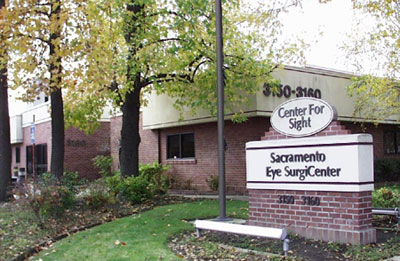Directions
Center for Sight
3160 J Street
Sacramento, California 95816-4403
Phone:
916-446-2020
800-828-EYES
Hours:
Monday – Thursday: 7:45am-5pm
Friday: 7:45am-4pm
General Directions

From Elk Grove merge onto CA-99 North towards Sacramento and take the N Street exit. Make a slight left onto 30th Street, take a right onto J Street and the destination is on the right side.
From Placerville merge onto US-50 West towards Sacramento, take Stockton Blvd exit & turn Right onto Stockton Blvd. Turn right onto Alhambra Blvd then another right onto J Street. The destination will be on the right side.
From Reno merge onto I-80 West towards Sacramento then merge onto Capitol City Fwy West towards Sacramento. Take the J Street exit and turn left and the destination will be on your right side.
From San Francisco take I-80 East towards Berkeley/Sacramento. Take US-50 East towards South Lake Tahoe and merge onto I-80 towards Reno. Take the N Street exit and make a slight left onto 30th Street. Turn right onto J Street and the destination is on the right side.
Eye Doctor in Sacramento
Dr. Keith Liang, MD, is a board-certified ophthalmologist and experienced eye surgeon based in Sacramento, California. He specializes in advanced treatments for cataracts and glaucoma, as well as LASIK and laser vision correction. Dr. Liang earned his undergraduate degree from UCLA, his medical degree from USC, and completed his residency at Louisiana State University-Lions Eye Center. He is known for his personalized patient care and dedication to using the latest technology to improve vision outcomes. He was the first surgeon in Sacramento to perform LASIK eye surgery. Dr. Liang’s expertise and commitment have made him a trusted provider in the Sacramento area.
Services
- Cataract Surgery – Cataract surgery is an incredibly effective way to bring clarity back to vision clouded by cataracts, which make the eye’s natural lens foggy. During the procedure, the cloudy lens is removed and replaced with a custom-fit intraocular lens (IOL) tailored to your specific vision needs. Advanced IOLs can also tackle issues like astigmatism, bringing even greater clarity and boosting quality of life.
- Cornea – Corneal care is all about maintaining and protecting the eye’s transparent, dome-shaped front layer. Conditions like keratoconus, infections, or injuries can damage the cornea, affecting vision. Treatments such as corneal cross-linking, transplants, and laser procedures are available to restore corneal strength, clarity, and comfort, helping to keep vision crisp.
- Dry Eyes – Treating dry eyes involves understanding and addressing the underlying causes of symptoms like irritation, redness, and blurry vision. Solutions can include anything from artificial tears and simple lifestyle changes to advanced treatments like punctal plugs. By improving the tear film’s health and reducing inflammation, patients find lasting comfort and relief from dryness.
- EVO ICL – The EVO Implantable Collamer Lens (ICL) offers a unique solution for those with moderate to high nearsightedness. Unlike LASIK, EVO ICL doesn’t reshape the cornea; instead, it places a thin lens inside the eye to deliver sharp, lasting vision correction. This reversible procedure is ideal for those with thinner corneas, giving a flexible yet permanent option for improved sight.
- Glaucoma – Glaucoma treatment aims to lower eye pressure to protect the optic nerve from damage—a silent but serious risk to vision. Options like eye drops, laser treatments, or minimally invasive glaucoma surgeries (MIGS) are tailored to each patient’s needs. Early diagnosis and consistent monitoring are essential for avoiding vision loss in this often-undetected condition.
- LASIK – LASIK (Laser-Assisted In Situ Keratomileusis) is a widely chosen laser vision correction that reshapes the cornea to fix issues like nearsightedness, farsightedness, and astigmatism. Using precision lasers, LASIK provides clearer vision with minimal recovery time, letting many patients reduce or even eliminate their need for glasses or contacts.
- Medical Eye Conditions – Effective management of medical eye conditions is essential for maintaining eye health over the long term. Diseases like diabetic retinopathy, macular degeneration, and uveitis need specialized treatment to protect the eye’s structure and function. A comprehensive approach, often involving medications, injections, or laser therapy, is key to preserving vision.
- Near Vision/Reading – As we get older, close-up vision tends to decline due to presbyopia, making tasks like reading harder. Solutions for near vision include reading glasses, progressive lenses, or surgeries like monovision LASIK and presbyopia-correcting implants. These options restore clear close-up vision, bringing comfort to everyday activities.
- Retina – Retinal care addresses issues with the retina—the eye’s light-sensitive layer responsible for central and peripheral vision. Conditions like retinal tears, detachment, diabetic retinopathy, and macular degeneration need swift treatment to prevent vision loss. From laser therapy to injections and surgery, these treatments are aimed at preserving and improving vision where it matters most.